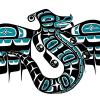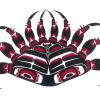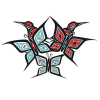Jason LaClair
































Imbued with a sense of rich tradition, nuanced storytelling, and inventive artistic techniques, Coast Salish art beautifully encapsulates the cultural heritage of the indigenous peoples hailing from the Pacific Northwest Coast of North America. While sharing some geographic and cultural commonalities with their northern neighbors, the Coast Salish peoples have developed an aesthetic language distinctly different from the form-line art of northern tribes, such as the Tlingit and Haida.
The artistic lexicon of traditional Coast Salish art embraces a flowing and somewhat minimalist geometry. The art forms are frequently characterized by the use of elements such as sweeping lines, concentric circles, crescents, and ovoids. The works often depict representations of the natural world—animals, humans, and landforms—in a less abstract and more lifelike manner than is common in other Northwest Coast artistic traditions.
In the contemporary realm, artists are innovating on these foundational aspects while responding to modern contexts and incorporating new materials. For instance, acclaimed artist Susan Point has been instrumental in reviving and redefining Coast Salish aesthetics. Born into the Musqueam First Nation, Point has navigated a path of artistic exploration that weaves together ancient Salish designs with her own modern, personal interpretations. Her work, ranging from delicate jewelry and prints to large-scale public installations, has pushed traditional forms into new territories and garnered international recognition.
Furthermore, contemporary Coast Salish artists often reflect on themes that resonate with the current indigenous reality. They navigate the dual nature of their existence, staying rooted in the past with their rich ancestral heritage while responding to the present-day challenges of colonialism, industrialization, and environmental issues. This combination of tradition and innovation, memory and prophecy, imbues their work with a vibrant relevance that continues to captivate audiences. The legacy of Coast Salish art is not only a testament to a storied past, but also a living, evolving expression of indigenous identity and resilience in the modern world.
































Join us for a journey into the world of Traditional and Contemporary Salish art.
Join us for an extraordinary evening celebrating Indigenous fashion and creativity at Bellis Fair Mall, where the Native American Student Union (NASU) and Northwest Indian College are collaborating to showcase the vibrant intersection of traditional and contemporary Indigenous style. This fashion show features works from talented Native designers and students, highlighting the rich cultural heritage and modern interpretations of Indigenous design in our Pacific Northwest community.
